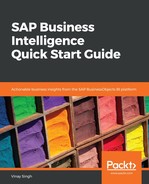To analyze and create insights in the workbook, we need data. The sources for this data could be SAP BEx queries, query views, and SAP NetWeaver BW InfoProvider. The data is displayed in the workbook in crosstabs. We can insert multiple crosstabs in a workbook with data from different sources and systems. If the workbook is going to be used by different users, it is also helpful to add info fields with information on the data source and filter status. We can also plan business data based on the current data in our data source.
Let's walk through the process of inserting a data source into a workbook:
- From the worksheet, choose the cell where the selected data source will be inserted.
- Select Insert Data Source and log on to the SAP BusinessObjects BI platform dialogue box. Enter User and Password. Enter WEB Service URL.
If you're logging on with the initial password (user of BW system), you might be asked to change your password.
- Click on OK; this will take you to Select Data Source.
- In the next screen, select Show Connections:
- By selecting Select All, all present systems, Cubes/InfoProvider, and Query/Query view are displayed on the BI platform
- If you tend to select Query/Query view, all present queries and query views are displayed on the BI platform
- If you make the selection of Local System, all systems in our local SAP log will be displayed
- By selecting Cubes/InfoProvider, all present cubes and InfoProvider will be displayed on the BI platform
- If you select System, all present systems will be displayed
-
After choosing the connection, click on Next:
- Based on the connection choice, you'll have different actions, for example, to select a query view or InfoProvider, you'll have to do a double-click to select the object.
- Then, select Logon to System.
- Enter your user log in details that you would have got from the administrator. Go to Client, enter User and Password, and then click on OK.
- Now, we select Data Source | OK.
- For the data sources based on SAP HANA, we can do the following:
- Search: A wild card can be used before or after a partial string if we need to retrieve data sources that have a unique pattern. Search selection can be based on description, technical name, or All.
- Area: We can choose either All, Cube, Attribute, or Dimension View and, based on what we choose, it'll display the objects.
- Similarly, for the BW system, we can do the following:
- Search
- Area
- Workspace
- Role
- Now, a new crosstab should be with us, consisting of the data from the selected data source that's inserted into the worksheet. Some of the groups are mentioned as follows; this will give you an overview of the uses of these groups:
- Data Analysis: This group consists of mainly Prompts, Filter, Sort, and Hierarchy:
- Prompts: This is used for query parameters and variable values
- Filter: This is used to define the filtering criteria
- Sort: This helps to quickly identify the data
- Hierarchy: This is used to define hierarchy options such as parent child position and level
- Presentation: In this group, we can specify settings for analysis in Microsoft PowerPoint:
- Refresh Presentation on Opening: By selecting this, each time the presentation is opened, the data sources are refreshed. If this isn't selected, the data in the presentation isn't automatically refreshed on opening. It's also possible to do a manual refresh by choosing Refresh All.
- Force Prompt for Initial Refresh: On every refresh, the prompting dialogue gets displayed.
- Store Prompt with Presentation: The defined prompt values are saved with the presentation.
- Remove Data Before Saving: When this option is marked, the presentation will get saved without the data. When you reopen the presentation, the data won't be displayed. To have the data displayed, you'll have to choose Refresh All.
- Insert: The group contains the Charts and Info Filed tabs:
- Charts: Used to insert dynamic charts. The chart is added according to the configuration. It's automatic when you change the displayed data in the crosstab.
- Info Field: This is used for inserting information fields to provide additional information on data displayed in the workbook sheets.
- Data Analysis: This group consists of mainly Prompts, Filter, Sort, and Hierarchy:
